Notice: Most of the graphics used for this page are selected from educational and scientific websites. In all cases the graphic links to the original website. We do not guarantee the accuracy of these sites, but many of them are of high quality and we encourage the interested reader to read them thoroughly.
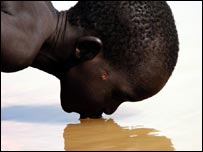
|
Global Water Crisis
Water has been identified as a central challenge for humanity in the coming decades. 1
Human Health
Approximately 17% of the global population (1.1 billion people) lack access to safe water sources. 2, 2E Inadequate drinking water supply is among the world's major causes of preventable morbidity and mortality . Approximately 3.4 million water related deaths occur annually, of which WHO estimates 1.8 million die of diarrheal disease and that 90% of those are children. 3 A child under the age of five dies from diarrhea every 18 seconds, placing diarrhea ahead of diseases such as malaria or tuberculosis as a cause of child mortality.
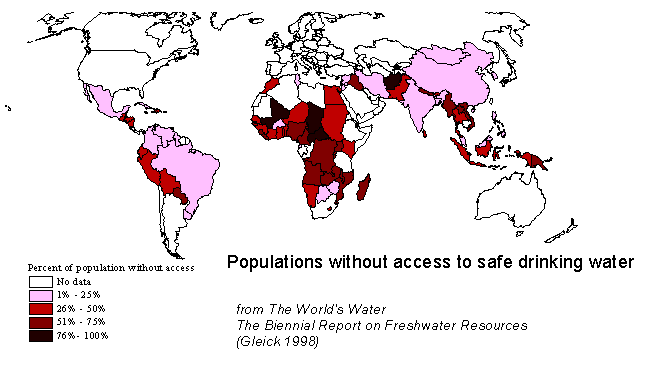
Society and Gender
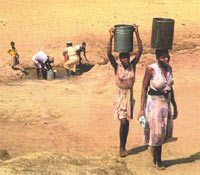 Water related health burdens are often disproportionally born by women and children who may forego schooling and childhood in order to transport water from distant sources. Women and children are also often responsible for the gathering of fuel wood both for cooking and for boiling the polluted water.
4
,
5
Fire based cooking and water pasteurization remains the norm in many parts of the world (see for example the map of Mexico)
As a result, indoor smoke pollution is estimated be the 8'th most important health risk factor globally.
6
According to
the World Bank
"The economic cost resulting from disease and reduced school attendance cannot be understated. Ultimately, the human cost is incalculable".
6a
Water related health burdens are often disproportionally born by women and children who may forego schooling and childhood in order to transport water from distant sources. Women and children are also often responsible for the gathering of fuel wood both for cooking and for boiling the polluted water.
4
,
5
Fire based cooking and water pasteurization remains the norm in many parts of the world (see for example the map of Mexico)
As a result, indoor smoke pollution is estimated be the 8'th most important health risk factor globally.
6
According to
the World Bank
"The economic cost resulting from disease and reduced school attendance cannot be understated. Ultimately, the human cost is incalculable".
6a
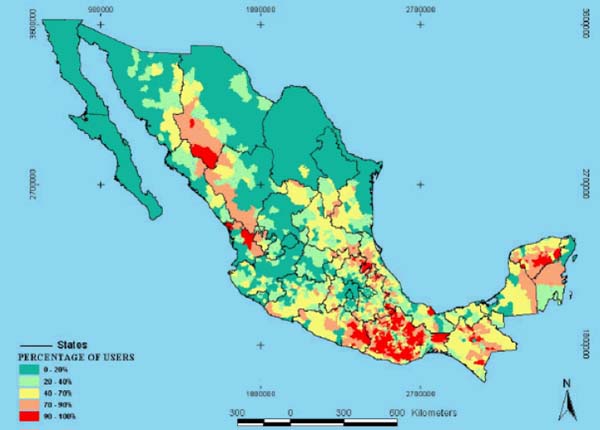
Percentage of the Population of Mexico that use fuel wood, at the municipal level.
Masera, Drigo, Trossero 2003

Environmental Impact
The use of wood fires to boil and pasteurize bacterially contaminated water is not only a burden on people whom must spend ever greater amounts of time seeking firewood but it may also denude the local landscape. This in turn increases soil erosion and reduces the tradition reservoir recharge rate from precipitation.
The water table under some of the major grain-producing areas in northern China is falling at a rate of five feet per year, and water tables throughout India are falling an average of 3-10 feet per year. 7, 8 The High Plains-Ogallala Aquifer stretching from Texas to South Dakota and providing an estimated 1/3 of all US irrigation water is also dropping at similar annual rates. 9, 10, 11
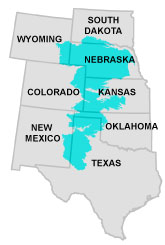
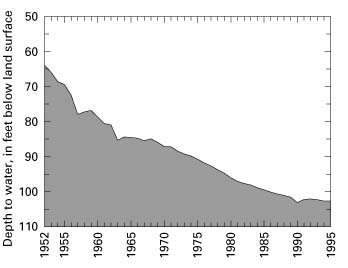
The boundaries Ogallala or High Planes Aquifer (left)
Water table of a well in Scott County, West Kansas from 1952-1995. (right)
As fresh water is removed from underground aquifers, lateral flow of seawater from the coast and effluence from agricultural and industrial practice may make its way into these traditional water reservoirs. Thus the quality as well as the quantity of fresh water remaining in these aquifers suffers. Digging deeper wells only exacerbates the rate of aquifer depletion and increases contamination due to salinization (See this graphic).
Conflict and War
The US National Intelligence Council and others project that water related problems are only going to get worse. 7, , 7A Estimates suggest that by 2015, 3 billion people will live in countries that are water-stressed and the experts are warn of the possibility of armed conflict over water resources. 7, 13
Water Crisis in Mexico
Mexico serves as a global microcosm with regards to the water crisis. In 2005 the Secretariat of Health estimated that 17% of the Mexican population (18 million people) do not have drinking water of the "appropriate bacteriological quality" and that over 30% of the rural population do not have potable water. 14
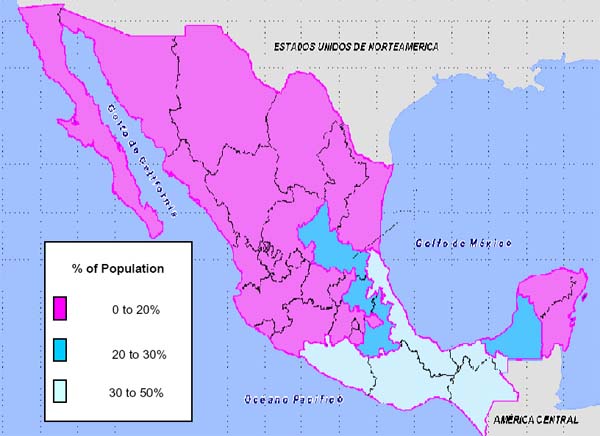
Percentage of the Population of Mexico without piped water, by state.
Comsion Nacional de Agua 2000
Climate models suggest that Mexico is likely to be facing significant decreases in precipitation in the coming decades , the country's southern most state of Chiapas has already seen water related violence. The population of Chiapas, one of the poorest states in Mexico, is largely indigenous, largely without piped water, sewage, and dependent upon firewood for cooking and disinfecting water(see figures below). 14 A 2003 study by the Salud Publica de Mexico 15 found that in the highly deprived areas in the border region of Chiapas, Mexico that 67% of the children under 15 years of age had intestinal parasites and 60% had multiple parasitic infections. A similar study 16 in 2000 found that less 31% of households in this area had drinking water adequate for human consumption.
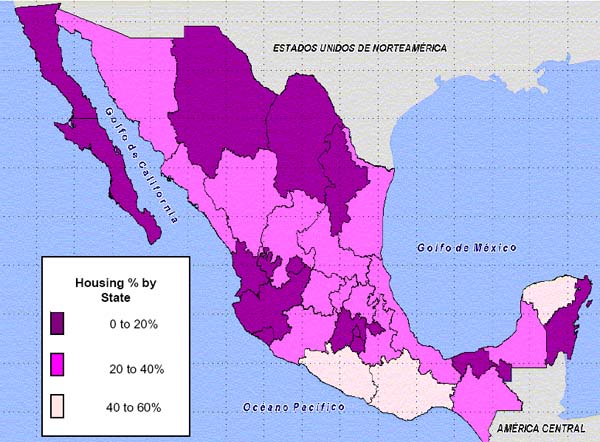
Percentage of homes in Mexico without sewage systems, by state.
XI General Census of Population and Housing- INEGI 2000
Learn more about how the water crisis relates to climate and energy.
Learn more about water science generally.
Learn more about Science for the People's Baja water survey.
Learn more about water footprints.
1. Water Scarcity a Looming Crisis? Alex Kirby, BBC News. 10/19/04
2. Water, Sanitation, and Hygiene Links to Health. World Health Organization. 2005.
2E. Spanish version: Water, Sanitation, and Hygiene Links to Health. World Health Organization. 2004.
3. Costs and benefits of water and sanitation improvements at the global level. Water Sanitation and Health; world Health Organization. 2004.
3A. Water, Sanitation, and Hygiene Links to Health. Water Sanitation and Health; World Health Organization. 2004.
4. Fuel for the Fire. Jaime Little. The Dominion: from the grassroots; 42. 1/2/2007. ,
5. In Darfur Wood-gathering Women Walk Through a Minefield of Rape. News From the Field- Sudan. Mark Fritz. International Rescue Committee. 2004.
6. Indoor Air Pollution. Public Health at a Glance. The World Bank. 2003.
6a. The World Bank's Increased Focus on Basic Sanitation and Hygiene. Water Supply and Sanitation. The World Bank. 2006
7, 7A Global Trends 2015: A Dialogue About Future With Nongovernment Experts. The National Intelligence Council. 2000.
8. Plan B: Rescuing a Planet Under Stress and a Civilization in Trouble: Falling Water Tables- Emerging Water Shortages. Lester Brown; Eath Policy Institute W.W. Norton & Co., NY: 2003.
9. Map: The world's water hotspots. BBC online interactive map. 2004.
10. Forecasting by analogy: societal responses to regional climatic change. Summary Report, Environmental and Societal Impacts Group NCAR, The Ogallala Aquifer Depletion. Glantz, Michael, ed., 1989.
11. Depletion of the High Planes Aquifer. US Geological Survey Program in Kansas. 1996.
12. Emerging Trends Report: Agua Caliente. Richard Karn. March 29th, 2006
13. Global Policy Report: Water teh Looming Source of World Conflict. Agence France Presse March 20, 2001
14. Children's Health and the Environment in North America: A first report on available indicators and measures. Country Report: Mexico. Secretariat of Health- Mexico. December 2005.
15. Morales-Espinoza, E.M.; Sánchez-Pérez, H.J.; García-Gil, M.; Vargas-Morales, G.; Méndez-Sánchez, J.D.; Pérez-Ramírez, M. Intestinal parasites in children, in highly deprived areas in the border region of Chiapas, Mexico; Salud pública Méx vol.45 no.5 Cuernavaca Sep./Oct. 2003; ISSN 0036-3634
16. Sánchez-Pérez, H.J.; Vargas-Morales, M.G.; Méndez-Sánchez, J.D.; Calidad bacteriológica del agua para consumo humano en zonas de alta marginación de Chiapas. Salud pública Méx vol.42 no.5 Cuernavaca Sept./Oct. 2000; ISSN 0036-3634